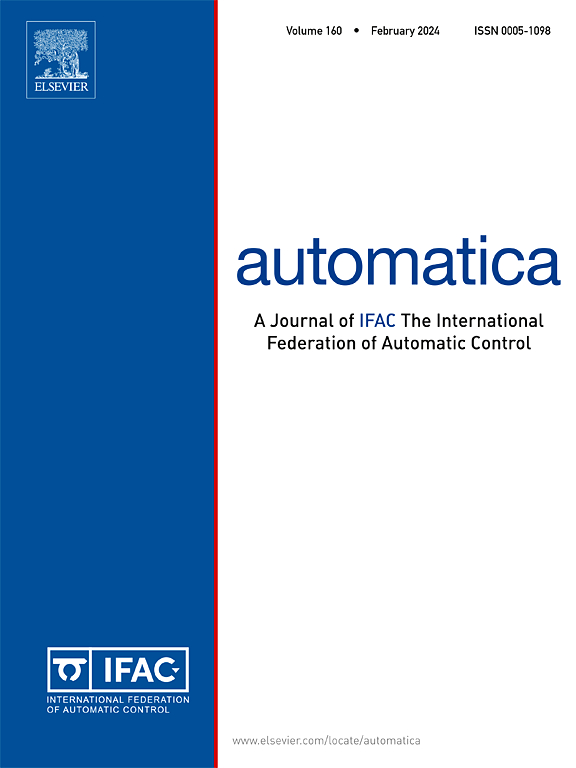玩还是不玩:对一类LQ微分博弈中对手边际贡献的描述
IF 4.8
2区 计算机科学
Q1 AUTOMATION & CONTROL SYSTEMS
引用次数: 0
摘要
研究了一类线性二次有限视界微分对策,该对策考虑了状态上的迈耶代价,目的是评估对手存在的影响。通过比较最优控制(在没有对手的情况下)和微分对策中出现的潜在里卡蒂微分方程的解,可以定量地描述其他玩家的贡献。在开环纳什均衡的情况下,贡献可以明确地表征,因为在考虑的一类博弈中产生的耦合非对称里卡第微分方程集的闭形式解可以计算。底层解决方案的构建取决于坐标的时变变化,导致每个参与者的平衡状态变量恒定。此外,在这种情况下,我们进一步深入了解了协同状态变量的作用,类似于最优控制问题中出现的那些变量。对于反馈纳什均衡,相关的耦合对称微分Riccati方程的闭型解不能确定。因此,通过依赖函数近似方法来提供解的估计。结果表明,这足以表征对手对反馈纳什均衡的贡献。本文章由计算机程序翻译,如有差异,请以英文原文为准。
To play or not to play: A characterization of the marginal contribution of the opponent in a class of LQ differential games
A class of Linear Quadratic (LQ) finite-horizon differential games involving a Mayer-type cost on the state is studied with the aim of assessing the effect of the presence of an opponent. The contribution of the other player is quantitatively characterized by comparing the solutions of the underlying Riccati differential equations arising in the optimal control (in the absence of the opponent) and in the differential game. In the case of open-loop Nash equilibria, the contribution can be explicitly characterized, since closed-form solutions to the set of coupled asymmetric Riccati differential equations arising in the considered class of games can be computed. The construction of the underlying solutions hinges upon a time-varying change of coordinates, leading to constant equilibrium costate variables for each of the involved players. Moreover, in this setting, we provide further insights on the role of the costate variables similar to those arising in the context of optimal control problems. For feedback Nash equilibria a closed-form solution to the related coupled symmetric differential Riccati equations cannot be determined. Therefore an estimate of the solution is provided by relying on a functional approximation approach. It is shown that this is sufficient to characterize the contribution of the opponent also for feedback Nash Equilibria.
求助全文
通过发布文献求助,成功后即可免费获取论文全文。
去求助
来源期刊

Automatica
工程技术-工程:电子与电气
CiteScore
10.70
自引率
7.80%
发文量
617
审稿时长
5 months
期刊介绍:
Automatica is a leading archival publication in the field of systems and control. The field encompasses today a broad set of areas and topics, and is thriving not only within itself but also in terms of its impact on other fields, such as communications, computers, biology, energy and economics. Since its inception in 1963, Automatica has kept abreast with the evolution of the field over the years, and has emerged as a leading publication driving the trends in the field.
After being founded in 1963, Automatica became a journal of the International Federation of Automatic Control (IFAC) in 1969. It features a characteristic blend of theoretical and applied papers of archival, lasting value, reporting cutting edge research results by authors across the globe. It features articles in distinct categories, including regular, brief and survey papers, technical communiqués, correspondence items, as well as reviews on published books of interest to the readership. It occasionally publishes special issues on emerging new topics or established mature topics of interest to a broad audience.
Automatica solicits original high-quality contributions in all the categories listed above, and in all areas of systems and control interpreted in a broad sense and evolving constantly. They may be submitted directly to a subject editor or to the Editor-in-Chief if not sure about the subject area. Editorial procedures in place assure careful, fair, and prompt handling of all submitted articles. Accepted papers appear in the journal in the shortest time feasible given production time constraints.
 求助内容:
求助内容: 应助结果提醒方式:
应助结果提醒方式:


